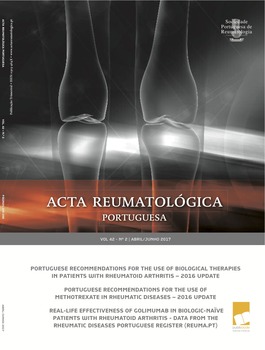Real-life effectiveness of Golimumab in biologic-naïve patients with rheumatoid arthritis - data from the Rheumatic Diseases Portuguese Register (Reuma.pt)
Authors
Ana Filipa Mourão; Célia Ribeiro; Joana Borges; Maria João Gonçalves; Miguel Bernardes; Susana Fernandes; Raquel Dezerto; Pedro Laires; Patrícia Machado; Mónica Eusébio; Maria José Santos; Helena Canhão;
Objectives. To assess the effectiveness of subcutaneous Golimumab 50 mg/monthly combined with methotrexate (SC GLM + MTX) over 52 weeks of treatment, in biologic-naïve RA patients, in a multicentre nationwide cohort from the Rheumatic Diseases Portuguese Register (Reuma.pt).
Methods. Data for this observational study was collected from March 2011 to August 2015. Disease activity (DAS28), functional capacity (HAQ) and Patient Global Disease Assessment (PGDA) were measured at baseline and weeks 12, 24 and 52 of treatment. The primary objective was clinical remission over 52 weeks (1 year) and secondary objectives were: functional response and functional remission over 52 weeks, variation of individual components of DAS over time and treatment persistence at week 52. Comparison between baseline variables of subjects with and without clinical remission was performed. The SC GLM + MTX persistence rate was estimated by the Kaplan-Meier analysis. Cox proportional hazard model approach was used to evaluate predictive factors of persistence, response and remission.
Results. A total of 109 patients were enrolled in the study: 94 (86.2%) female, mean age 55.5±13.2 years, mean age at diagnosis 45.5±13.5 years, mean age at beginning of treatment with biologic agents 53.1±13.1 years; 78.1% positive for serum rheumatoid factor. All patients were biologic-naïve and had active disease, despite previous treatment with conventional DMARDs. At the time of this analysis, 93 patients had a follow-up time of at least 52 weeks (i.e. started treatment before August 2014). Of this group, 38.3% achieved clinical remission, 91.9% functional response and 35.2% functional remission, over 52 weeks. Treatment persistence was 75.3% at 1 year. Disease activity indices were all statistically significantly lower at 12, 24 and 52 weeks when compared to baseline. Older age at diagnosis was associated to a lower probability of clinical remission (HR= 0.96, p= 0.031) whereas higher C-reactive protein baseline levels were associated with a lower probability of functional response (HR= 0.54; p= 0.026).
Conclusions. Golimumab 50 mg + MTX showed effectiveness in the treatment of patients with active RA, in accordance to what previously observed in clinical trials. A consistent and significant decrease in RA disease activity through 52 weeks of treatment and a significant functional improvement were observed, as well as a high persistence on treatment.
Ana Filipa Mourão
Hospital Egas Moniz (Centro Hospitalar de Lisboa Ocidental)
Célia Ribeiro
Hospital de Faro (Centro Hospitalar do Algarve)
Joana Borges
Instituto Português de Reumatologia
Maria João Gonçalves
Hospital de Santa Maria (Centro Hospitalar de Lisboa Norte)
Miguel Bernardes
Centro Hospitalar de São João
Susana Fernandes
Instituto Português de Reumatologia
Raquel Dezerto
Merck Sharp & Dohme
Pedro Laires
Merck Sharp & Dohme
Patrícia Machado
Merck Sharp & Dohme
Mónica Eusébio
Sociedade Portuguesa de Reumatologia
Maria José Santos
Hospital Garcia de Orta
Helena Canhão
Faculdade de Ciências Médicas da Universidade Nova de Lisboa
Hospital Egas Moniz (Centro Hospitalar de Lisboa Ocidental)
Célia Ribeiro
Hospital de Faro (Centro Hospitalar do Algarve)
Joana Borges
Instituto Português de Reumatologia
Maria João Gonçalves
Hospital de Santa Maria (Centro Hospitalar de Lisboa Norte)
Miguel Bernardes
Centro Hospitalar de São João
Susana Fernandes
Instituto Português de Reumatologia
Raquel Dezerto
Merck Sharp & Dohme
Pedro Laires
Merck Sharp & Dohme
Patrícia Machado
Merck Sharp & Dohme
Mónica Eusébio
Sociedade Portuguesa de Reumatologia
Maria José Santos
Hospital Garcia de Orta
Helena Canhão
Faculdade de Ciências Médicas da Universidade Nova de Lisboa





